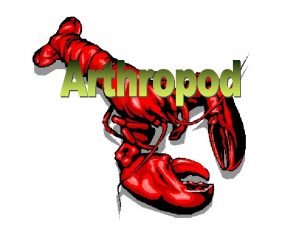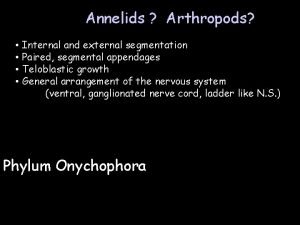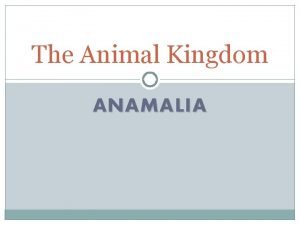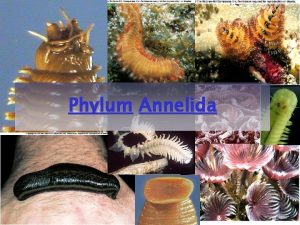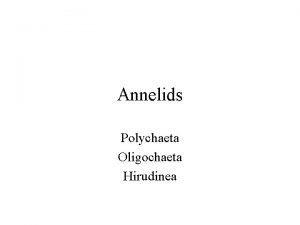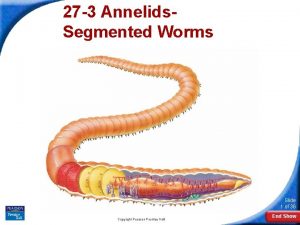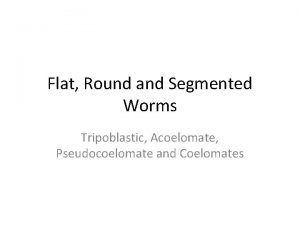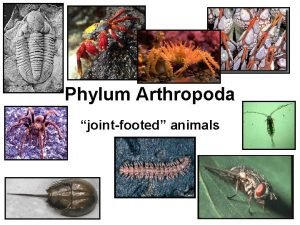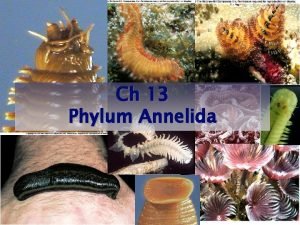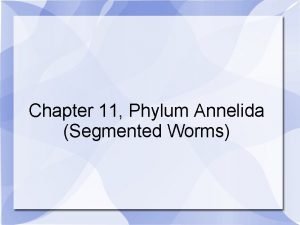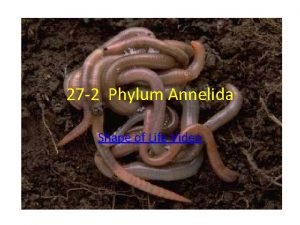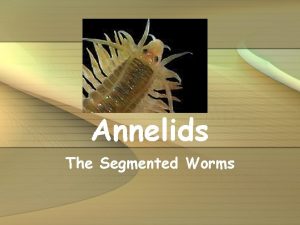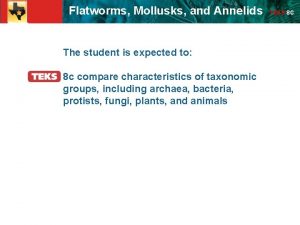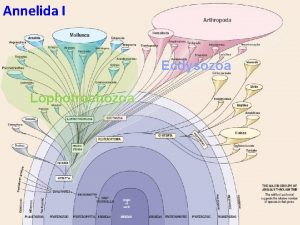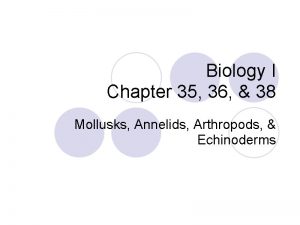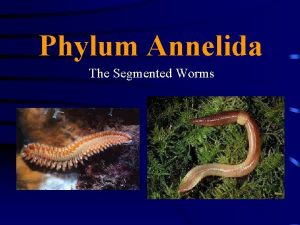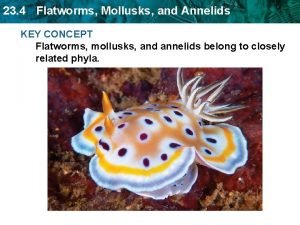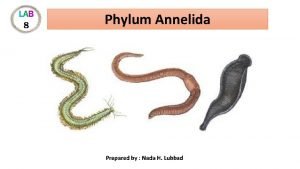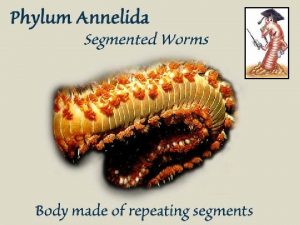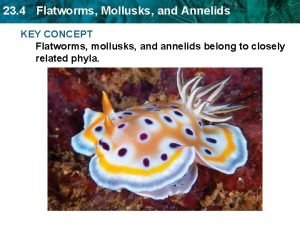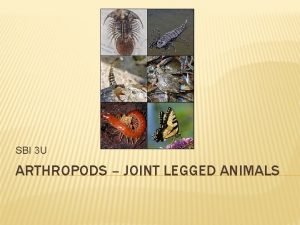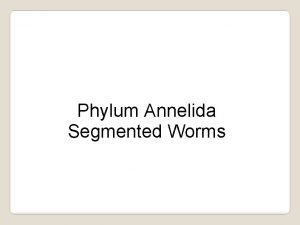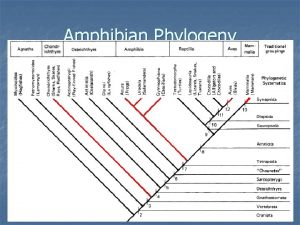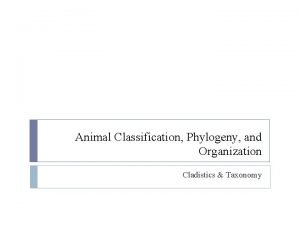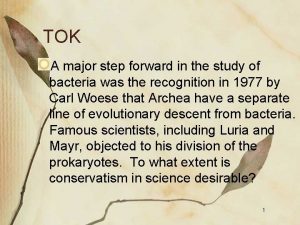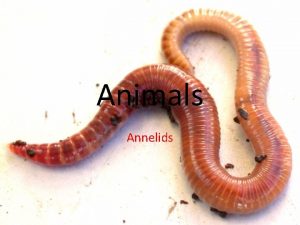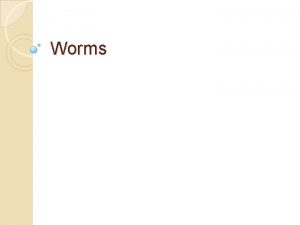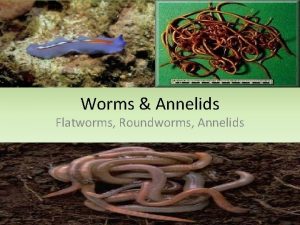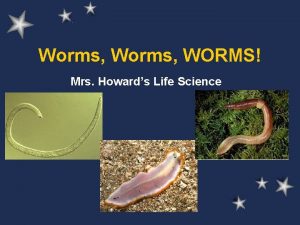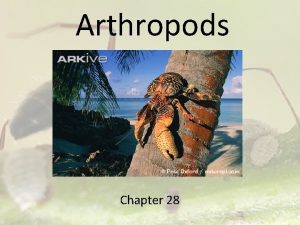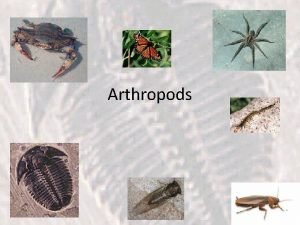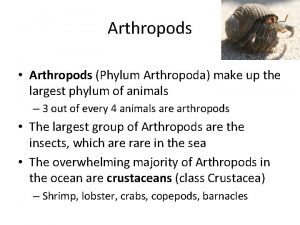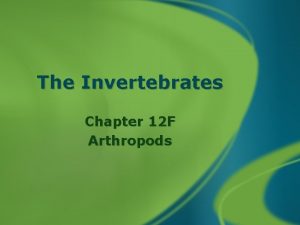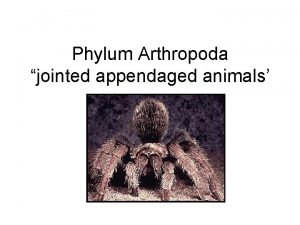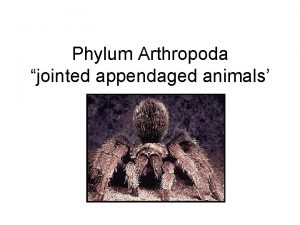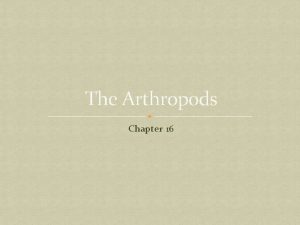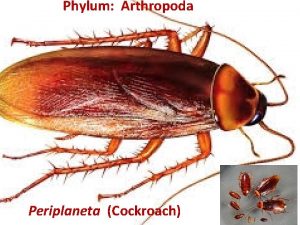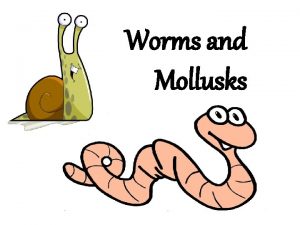Phylogeny of Arthropods Arthropoda Annelids worms Onychophorans worms
































- Slides: 32


Phylogeny of Arthropods Arthropoda Annelids (worms) Onychophorans (worms w/legs) Chelicerates (spiders) Crustaceans (lobsters) Trilobites (extinct) Worm-like Ancestor Insects (butterflies)

General Characteristics • segmented body • jointed appendages • bilateral symmetry • secreted exoskeleton • molting • open circulatory system • ventral nerve cord and brain

DIVERSITY Numbers • about 80% of all animals are arthropods • estimated to be over 30 million arthropods • far more of them than all other metazoan species combined • in virtually every conceivable environment: marine, terrestrial, freshwater, and aerial habitats. Phylum Arthropoda Subphylum Trilobita (extinct) Subphylum Chelicerata Subphylum Crustacea Subphylum Uniramia (insects)

Chelicerata • horseshoe crabs • mostly terrestrial • cephalothorax-abdomen • 6 pairs cephalothoracic appendages • chelicerae, pedipalps, 4 pairs legs • no antennae

Horseshoe Crab Limulus polyphemus, Carcinoscorpius rotunda, and Tachypleus gigas. • • Limulus is a benthic scavenger and predator. Prey include clams and other invertebrates that it digs for in the sand. The tail spine is used as a self-righting mechanism if the animal is overturned accidentally. Lives up to 19 years Reaches sexual maturity at about 9 to 12 years old

Horseshoe Crab • Mates during spring and summer full and new moons, onto ocean beaches. • Females lay up to 30 thousand eggs, which males fertilize before burying them in the sand • These eggs provide a major food source for migrating birds along the Atlantic coast. Those that are not eaten hatch during the next high tide, and the tiny larvae are carried away to sea.

Biomedical


Blue Blood Harvest

Subphylum Crustacea • • • two pairs antennae marine, freshwater, and terrestrial Primarily aquatic Free-floating larval stage 26, 000+ known species

Subphylum Crustacea brine shrimp Shrimps Crabs Lobsters Copepods Barnacles

Respiration Gills blood is oxygenated by gills oxygen delivered to tissues by blood crustacean gills are usually associated with appendages

Open Circulatory System Closed Circulatory System

NERVOUS SYSTEM Side view of body showing relative position of circulatory (yellow), digestive (green), and nervous (blue) systems.

SENSE ORGANS • receptors for light, vibrations, chemicals, equilibrium, gravity • cuticle modified to form a vast array of receptors (sensilla) Mechanoreceptors Chemoreceptors Equilibrium and Gravity Statocysts Tympanal Organs Hygroreceptors Photoreceptors Pigment-cup Ocelli Compound Eyes

Compound Eye Lens Crystalline cone Pigment cells Facet Visual cells Nerve fibers from visual cells Ommatidia Optic nerve

REPRODUCTION fertilization may be external or internal in aquatic arthropods always internal in terrestrial species

Arthropod Development Nauplius Zoea Megalops

Camouflage Decorator Crab Sponge crab

Camouflage: anemone crab

coral guard crabs and pocilloporid corals

gall crabs and pocilloporid corals


scarlet cleaner shrimp

sea cucumber crab and sea cucumbers

pompom crabs and sea anemones

crabs and sea anemones




 Crustaceans characteristics
Crustaceans characteristics Segmentation in arthropods
Segmentation in arthropods Anamalia examples
Anamalia examples Phylum
Phylum Polychaete body plan
Polychaete body plan Section 27-3 annelids
Section 27-3 annelids Are annelids acoelomates
Are annelids acoelomates Annelids
Annelids Annelida
Annelida Metamerism earthworm
Metamerism earthworm Annelids symmetry
Annelids symmetry Section 27-1 flatworms
Section 27-1 flatworms Shape of life videos
Shape of life videos Restperation
Restperation Spider phylum
Spider phylum Hirudenia
Hirudenia Section 4 flatworms mollusks and annelids
Section 4 flatworms mollusks and annelids Annelida lophotrochozoa
Annelida lophotrochozoa Mollusca segmentation
Mollusca segmentation Segmented worms characteristics
Segmented worms characteristics Section 4 flatworms mollusks and annelids
Section 4 flatworms mollusks and annelids Annelida
Annelida True coelom
True coelom Reviewing key concepts: flatworms, annelids, and roundworms
Reviewing key concepts: flatworms, annelids, and roundworms What is an annelid
What is an annelid Annelida nematoda
Annelida nematoda Annelids
Annelids Cross section of an earthworm
Cross section of an earthworm Lungfish vs spotted salamander
Lungfish vs spotted salamander Homoplasy
Homoplasy Monophyletic group
Monophyletic group Barnacle phylogeny
Barnacle phylogeny Outgroup on a cladogram
Outgroup on a cladogram
